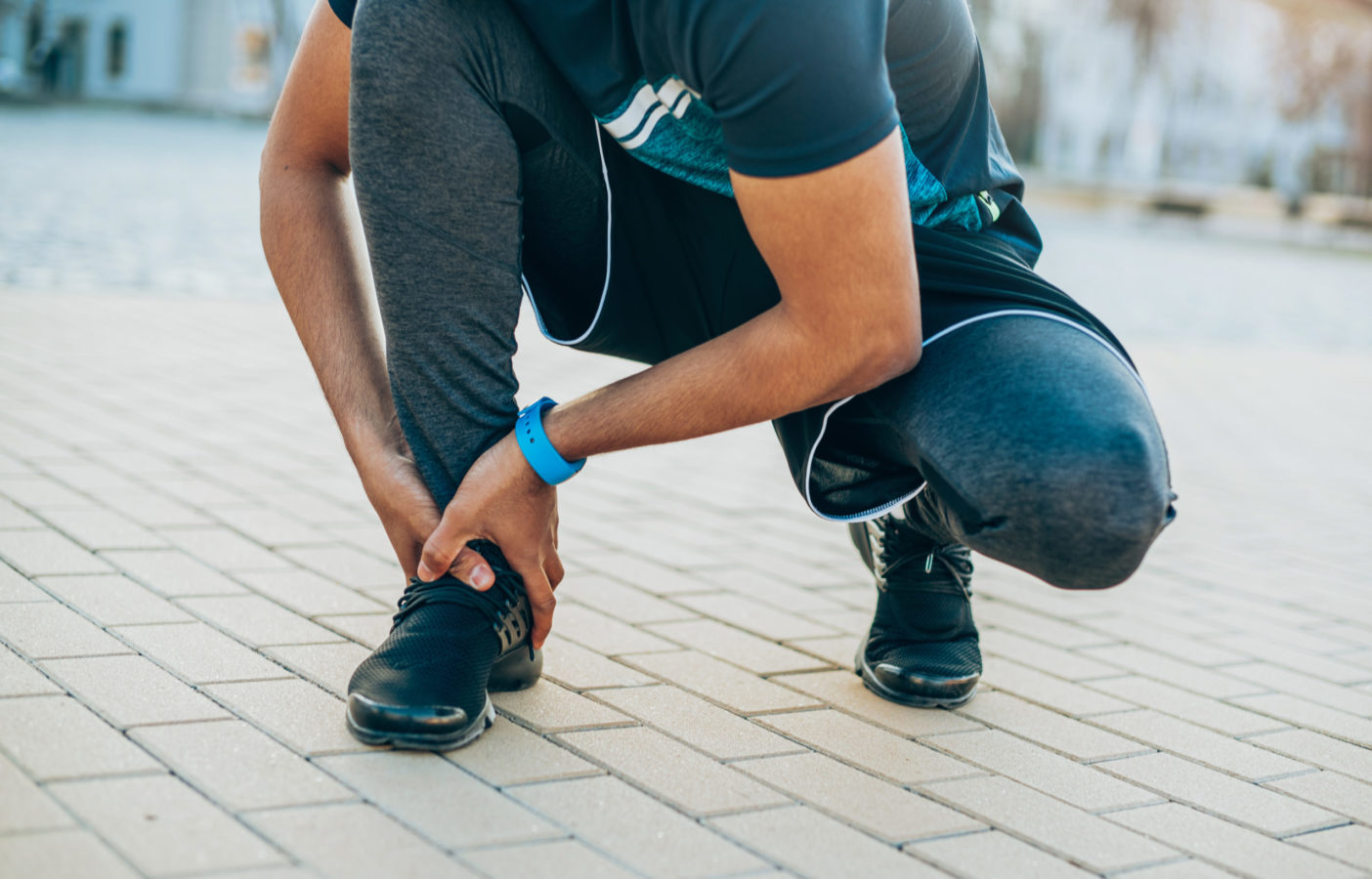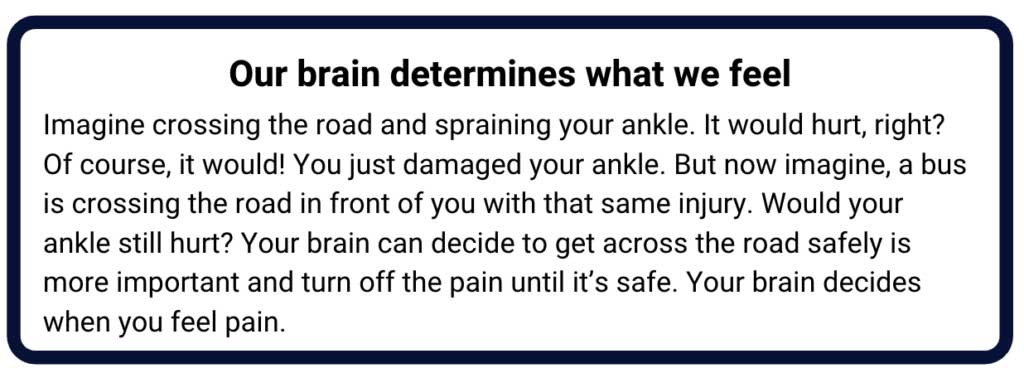
by Keri Rogers PT, DPT (Board Certified Orthopedic Clinical Specialist/Fellow, American Academy of Orthopedic Manual Physical Therapists)
(Part 2 of a 2 part series)
Pain is a normal part of the human experience. It is important to understand pain so that you can understand how to manage pain and maximize your function and quality of life.
We tend to understand pain when it is present in direct relation to an injury or event such as getting a paper cut, spraining an ankle or bumping our elbow. We all experience pain in our lives. Typically pain is short-lived and goes away within a few days to a few weeks. However, when pain persists it can alter our lives; causing us to stop participating in activities that we love. Pain can keep people out of work. Pain can make us feel isolated. It is important to understand what pain is and why we hurt.
Pain is an output of our nervous system which includes our brain and spinal cord. Pain begins as a response to an injury. The nerves in our body send a “danger” message to the brain. It is our brain, rather than the extent of the injury, that determines how much pain we will experience. Our brain can be influenced by memory, emotion, and context. This means that under certain conditions such as stress, fatigue or perhaps a recurrent injury we may experience more pain.
The Sensitive Alarm: Our nervous system can become more sensitive over time meaning that we may experience higher levels of pain or more widespread pain. This can also cause pain to become chronic or persistent. Our nervous system is like the central processor or “motherboard” for our body. It communicates with our body as to how it should feel. If the motherboard is overloaded or overly sensitive it can begin to cause other problems.
Not necessarily! Following an injury, an inflammatory response that includes pain is normal. However, all tissues in the body (muscles, ligaments, tendons, bones, nerves) heal within a few days up to about 12 weeks following an injury. Pain that persists beyond normal healing time frames does not mean that there is still damage present in the body.
Continuing with the idea of the “motherboard” of a computer-imagine the computer system within a car. All of the sensors in the car are controlled and triggered by the main computer. Most of the time when the check engine light comes on, there is a problem with the engine. However, there can be a “glitch” where one or more sensors come on when no problem is present or a problem with one part of the car (say the engine) may trigger a warning elsewhere (low tire pressure).
Our body can operate in a similar fashion. Sometimes our nervous system continues to send “danger” signals to our brain which then tells our body to experience pain although the tissues of the body have healed. It is possible to continue to experience pain though there is no injury present.
Pain is influenced by memory, beliefs, and the environment. For example, if you previously experienced a bad ankle sprain while hiking on a  rainy day you may experience similar levels of ankle pain if you are hiking again on a rainy day and misstep or step in a hole. Whether or not you actually sprain your ankle again, your nervous system and brain remember the injury that occurred in the past and can send the output of pain.
rainy day you may experience similar levels of ankle pain if you are hiking again on a rainy day and misstep or step in a hole. Whether or not you actually sprain your ankle again, your nervous system and brain remember the injury that occurred in the past and can send the output of pain.
Our beliefs also influence the amount and duration of pain that we experience. When we believe negative things about our bodies such as that “my body is falling apart” or “nothing will make me feel better” our pain can become elevated. This is similar to the idea of believing that you will have a bad day. If you have that mindset, then you will likely notice all of the negative things that occur (getting stuck in traffic, spilling your coffee, etc). On the other hand, if you have the outlook that you will have a great day, you will be more likely to focus on the good things that happen throughout the day (you arrived to work on time, your co-worker brought you coffee). You are living the same day, but the way that you experience the day can differ depending on your beliefs and attitude. Pain is very similar to a personal and emotional experience. Being positive does not mean that we will never experience pain, but it does mean that we don’t have to worry. Thinking positively can help you to take control of your pain.
Finally, the environment influences pain. This can include our physical environment, but also includes our internal environment such as the effects of stress and sleep. If we have many stressors occurring in our life (deadlines, family health issues, financial concerns), our pain experience can be elevated. When our bodies are tired and we lack sleep, we can also experience higher levels of pain. To explain this concept, I like to use the idea of filling a bucket of water. If you put an empty bucket under a faucet and turn the water on to a drip it will take a long time to fill the bucket. The empty bucket represents our lives with minimal stress when we are feeling good. However, if you put a full bucket under a faucet, just a drop or two may cause the bucket to overflow and spill all over the floor. The full bucket represents us when we have many stressors in our lives. We have very little room to handle any more input and even a very small event can create an “overflow” which can equate to pain.
Understanding pain is the first step to managing pain. Having a health care professional such as a physical therapist explain pain to you is a great first step. Physical therapy will also help to address mobility and strength deficits and maximize your function. A great first step is to repeat the mantra that “hurt does not equal harm.” Our bodies are resilient and strong and when we believe that we can take control of our pain, we can begin to see change.
Some lifestyle factors that can have a big impact on pain are stress, sleep, diet, and exercise.
Trying to manage stress in our lives can greatly help to reduce pain. This is not always easy to do, but finding time and ways to decompress is helpful. This may be through deep-breathing exercises, using a meditation app, or yoga. Asking for help from our family and friends to remove some of the stressors in our life may also be helpful.
The goal for sleep should be 8-10 hours per night. There are some positive sleep habits that we can develop to encourage rest. Even as adults, we should strive for a set bedtime. Our bodies respond well to routine. Having a night-time routine such as washing your face or reading for a set period of time may also help train our brain and body for sleep. Minimizing what you eat or drink before bed will help to ready our bodies for sleep and reduce the likelihood of waking up during the night. Finally, eliminating screen time within the hour for bed, including the use of phone, tablet, or television, will help to prepare the body for sleep.
Fueling the body through healthy foods can encourage healing and optimal function of the body systems. Avoid skipping meals and try to eat balanced meals including protein, fruits, and vegetables. Excessive sugar, alcohol, or caffeine may increase the pain experience.
Exercise helps to reduce pain! Most of us may want to avoid exercise when we hurt or be afraid that it will make us feel worse, but exercise is actually a great natural pain reducer. Our bodies are made to move! Exercise helps to increase blood flow and releases endorphins which is the body’s natural painkiller. Specific exercise guided by a physical therapist can also help to load tissues to encourage healing and to decrease threat.
If you are experiencing pain, physical therapy can help you. Physical therapists have an in-depth understanding of pain and the human body and can guide you through the process of rehab. You have the power to take control of your pain and live your best life!
Find a physical therapy clinic near you.